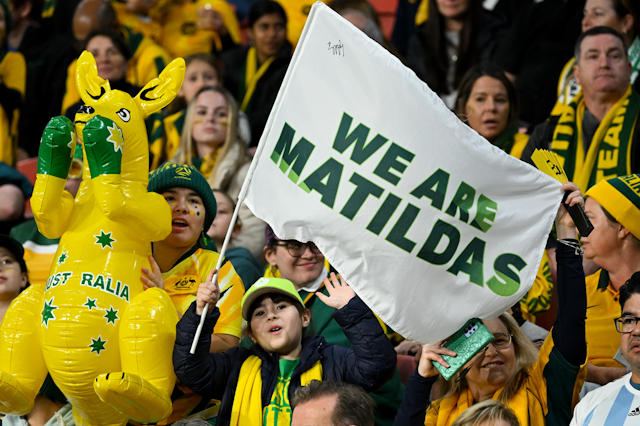Wednesday night saw the end of the Matildas’ nation-gripping FIFA Women’s World Cup pursuit, losing 3-1 to England in the semi-final in Sydney.
While it was an emotional finish to Australia’s exciting run, the match only further highlighted the record-breaking audiences experiencing the fan culture of women’s football.
This fandom has a notably different flavour from traditional men’s sports fan culture, and could be the defining legacy of the tournament.
A space for all
Women’s football, and most women’s sports, allow space for different fan cultures to come together in a safer and more inclusive environment.
These cultures have been developed over time by those who have felt excluded by traditional sporting environments that can promote toxic elements of masculinity and require fans to behave in particular ways.
Fans in many male sporting cultures are expected to have a prior knowledge, understand rules and intricacies of the game, wear particular merchandise and use specific language to show support. If fans don’t comply with these set behaviours, they can feel like they don’t belong.
Research has shown this is a particularly complicated experience for women. To fit in and feel part of men’s sporting fan culture, they have to modify parts of their gender identity.
Women’s sports create an environment where fans can come as they are, not as who they think they should be. This welcomes everyone to the game, especially people who might have previously looked at sport and thought it wasn’t for them.
A history of exclusion
It is no accident these spaces are welcoming, and speaks to the history of active exclusion women have faced in football.
Women’s international football took off in Australia in the mid-to-late 1970s, with the first recognised game between Australian and New Zealand. Coverage was scarce, and even when it was present, it was often sexist and demeaning.
The timing of this growth of the game is no coincidence, aligning with the FA’s (English Football Association) lifting of the 50-year ban of women’s football in England. The FA didn’t have the power to ban women from playing entirely, so in 1921 it ruled that women’s games couldn’t be played on FA-affiliated grounds.
This hindered the development of football not only in the UK, but around the world, as other nations echoed similar positions.
That there was an international team representing Australia in 1979 is credit to the women, and supportive men, who built spaces for women and girls to play.
In creating new clubs, teams, and competitions, they created environments demonstrating values that were the opposite of those that had previously excluded them.
Fans returning to the sports they love
These welcoming cultures aren’t exclusive to football. Many women’s sporting clubs in Australia have played key roles in contributing to the growing audiences that elite codes are experiencing today. Women’s sporting codes aren’t just attracting new fans but are also re-engaging fans formerly lost to sport.
Research I conducted into the developing fan culture of the AFLW found many fans came to women’s Australian rules football because they were interested in the code but felt alienated by the culture of the men’s game.
Fans shared that AFLW offered a more inclusive culture, and they didn’t have to navigate how to support athletes accused of domestic violence or sexual assault and fear racist or homophobic language. Fans also felt they could do things such as change teams and support multiple teams. People were fans of the competition more broadly and also wanted to generally support women playing the sport they love.
These findings aren’t just bound to Australia. There were distinctly different fan experiences at the men’s and women’s European Football Championships held in 2021 and 2022. Both finals were played in England and featured the hosts.
The men’s final was marred by fan violence, altercations with police and racism, while the women’s competition presented a safe, friendly and inclusive environment, .
Fans of women’s sport around the world are rejecting traditional masculine norms of sports fandom, and developing a counter fan culture.
Read more: Racism in sport: why it comes to the surface when teams lose
Inclusive supporter groups
Trailblazing volunteers, administrators, coaches and athletes built these spaces for women and non-binary folk to play. But there are also passionate fans on the ground continuing to drive the fan culture.
One group bringing the noise this Women’s World Cup is Matildas Active Support, which states “inclusivity is at our core”. The group coordinates meet-ups pre and post-match, leads chants at the games and brings fans together on social media. The group welcomes everyone to their events, whether that be singing at the top of their lungs or quietly taking it all in.
Diverse fan support like this adds to the family-friendly atmosphere at women’s football, where families with children feel more comfortable to attend, and women in particular feel safe to attend matches alone.
Fans the legacy of this world cup
It’s important women athletes are visible in the media to show the next generation what is possible, and the Matildas are definitely achieving this. But the visibility of fandom and the culture that surrounds women’s football is just as crucial to drive women’s sport forward.
This Women’s World Cup is an opportunity for stakeholders to learn more about the different ways fandom is experienced, and how to connect with diverse fans to continue to grow the audience beyond the tournament and in other women’s sports.
What’s been clear over the last month is that record numbers of women’s football fans have rejected traditional masculine forms of sporting fandom for more inclusive, safe, and friendly expressions.
These fans have been seen. They now must be heard to continue to build on this momentum for women’s sport.

